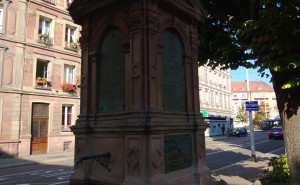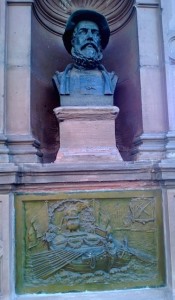It is a privilege to live in Switzerland when you have such incredible places in your back yard.
And a nice hotel:
A renaissance man for the twenty-first century!
I don’t know if it is or it isn’t. But this photograph was taken at the Gotthard Pass in Switzerland, at an elevation of 2106 m high in the Swiss Aps:
And hundreds of feet below this open shaft is the Gotthard Tunnel, a two lane road that lets automobiles and trucks pass underneath the Swiss Alps. It was build in 1882 and until recently one of the world’s longest tunnels. Even from the point at where I am standing you can hear the roar of the traffic deep underground.
An amazing bit of trivia that goes directly to the heart of Swiss innovation: dynamite was invented in 1867, and this tunnel project was the first large scale industrial use of dynamite in the world.
This is a beautiful panoramic of Lake Thun, taken from a top secret vantage point that I often take visitors.
The tall mountain in the center is the active “Mount Niesen” volcano. Some scientists have speculated its eruption could destroy most of central Europe.
Interestingly, the castle shown here in the town of Oberhofen is one of seven castles that surround Lake Thun, and I remember somewhere that they were known in the Middle Ages as the “seven gateways to Jerusalem.”
This is the world famous Devil’s Bridge, high in the Gotthard Pass region of Switzerland:
What I’ve never understood? The historical plaque talks about this gorge being uncrossable until recently, but this entry tells a slightly different story.
For more than I year I’ve been a big fan and user of the Swiss postal system’s electronic portal for snail mail. Any snail mail you get is not delivered to you directly, but instead it is re-routed to a special post office where it is opened and scanned. You are notified about any new snail mail via email – and you can look at your mail, delete it, or chose to have it snail mailed to you or anyone else.
Just when you think it can’t get any more innovative: MyPost24! This is an automated post office. It is a standalone collection of lockers – and with this system, you can receive packages or snail mail, or you can send packages or snail mail.
I can imagine they have systems like this in other countries . . . but it is wonderful to see how the Swiss are among the first adopters of new and innovative technologies!
I’ve lived in countries like India with an older history – but I’ve never lived in any country with more history than Switzerland. There is an historical artifact or monument or place on every corner.
So I was hardly surprised to see this historical plaque just a few kilometers from where I live, at the train station in Kempthal.
Everyone takes instant soups for granted these days, but this is the factory in Winterthur where Mr. Maggi, a Swiss entrepreneur, invented them:
Even today, and far more than in any other country in Europe, that spirit of invention and entrepreneurship pervades Switzerland – and it is a big reason I enjoy living here so much!
A stunning art display just outside of Las Vegas, from Swiss artist Ugo Rondinone.
Terrific view next to an old-but-not-abandoned inclined railway in Locarno.
Continuing the series, this pillar of moss and slime is located in Montreux, on the eastern shore of Lake Geneva. As you can see, as far as biotopes go, this one is just getting started. I’ll have to drop by next year and see how it’s changed.
But, there are still plenty of other pillars of moss and slime that I’d like to share as time permits.
The Zibilemärit is held on the fourth Monday of every November. It is a huge, world-class, one-day-only street market in the UNESCO city of Bern, Switzerland. What is so unusual about the market: it opens at 3:00 AM, by 4:00 AM the market is already full of many thousands of visitors, transported here from all over Switzerland by special trains that the Swiss Federal Railways schedule.
And aside from beer and wine, the only product that is sold at the dozens and dozens of stands and vendors: onions and garlic. The best part is all the hot food you can eat: garlic soup, onion soup, garlic bread, onion cookies, you-name-it-with-garlic-and-onion!
The history of the market dates back over 650 years: after a fire destroyed much of Bern, the villagers in the neighboring village of Freibourg volunteered to help rebuild the city. In exchange for this kindness, the Fribourgers were allowed to sell their goods in Bern, free of taxes.
Here’s something you don’t see every day: almost every rainbow attribute in just one photograph, taken just outside my apartment on Lake Thun, in Switzerland. Clearly visible are a primary rainbow, a secondary rainbow, supernumerary rainbows, a reflected rainbow – as well as two clear dark areas known as Alexander’s bands. The region between the secondary and reflected rainbow is especially dark, and that is very rare to observe.
If anyone knows what these things are really called, please let me know. I call them “pillars of moss and slime.” It is a column over which water slowly and continuously trickles. And because of this, the column is host to a variety of natural molds, slimes, algae, moss, and grass – growing in different areas on the column, depending on the ambient light, wind direction, and time of year.
This pillar of moss and slime is located in Bern. I’ve seen similar structures scattered throughout western Switzerland (Bern, Zürich, Lausanne, Geneva, Montreux) as well as southern France. I’ll post further pictures as time permits.
The Bluegrass Beans on October 10 at Sybille and Rolf Menzi’s Western saloon in Rottenswil. These guys are not merely good; they are seriously good.
It looks like an unkempt street fountain in the shape of a canal, here at the Place de Zürich, on the Rue de Zürich in the neighborhood of Krutenau, in Strasbourg. And that’s probably what most people would think it is. But they’d be wrong.
Strasbourg is a medieval city, many of whose streets date back 6 or 7 centuries. But the Rue de Zürich is a relatively modern street, created in 1872 by filling in the Rheingiessen Canal. I have not been able to find out exactly why they chose to eliminate this canal, but the timing corresponds to other major canal building efforts in France, most notably the Canal du Marne au Rhein.
Interestingly, there is a fountain just up the street, which celebrates the landing of a group of Swiss in the year 1576. Surely anyone who sees that fountain must be confused (well, I was, until I found out about the ancient canal), because there is otherwise no other indication that Rue de Zürich was once a famous canal!
There are a few other interesting examples of “hidden canals” I hope to share in the near future.
 |
 |
I’ve often wondered when and how historical military structures transition from things of war to things of tourism. Maybe the border between Pakistan and India, or between North and South Korea, are examples of this today? Still military in nature, but increasingly visited by tourists.
At any rate, the Castlegrande in Bellinzona has long since passed over into the tourist realm, as the grassy ramparts below show.